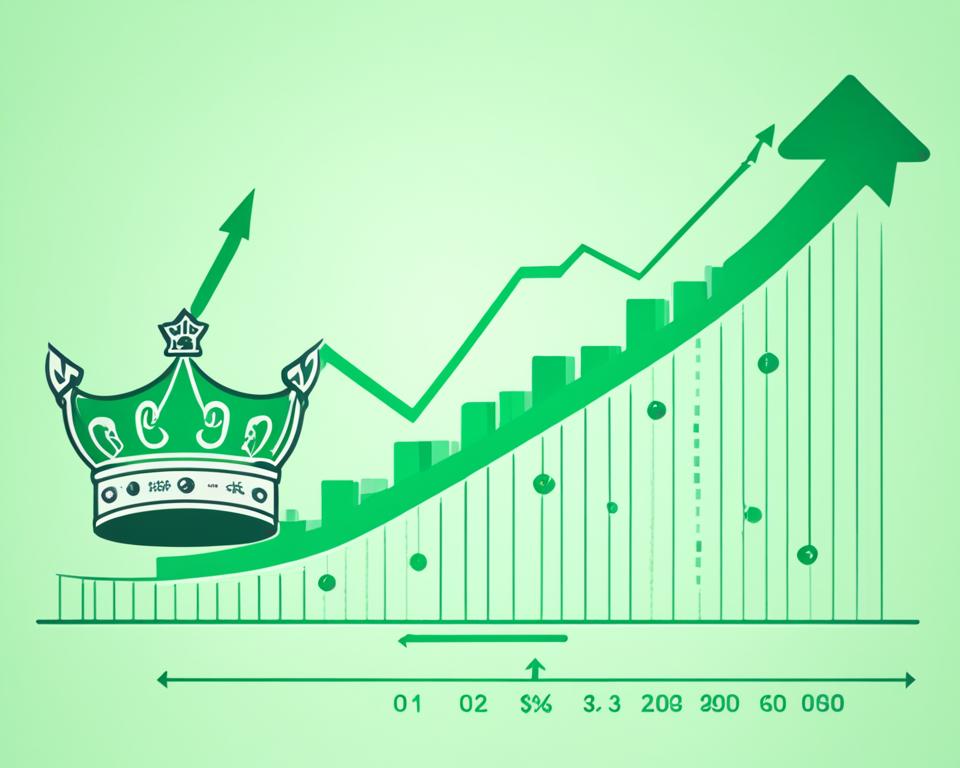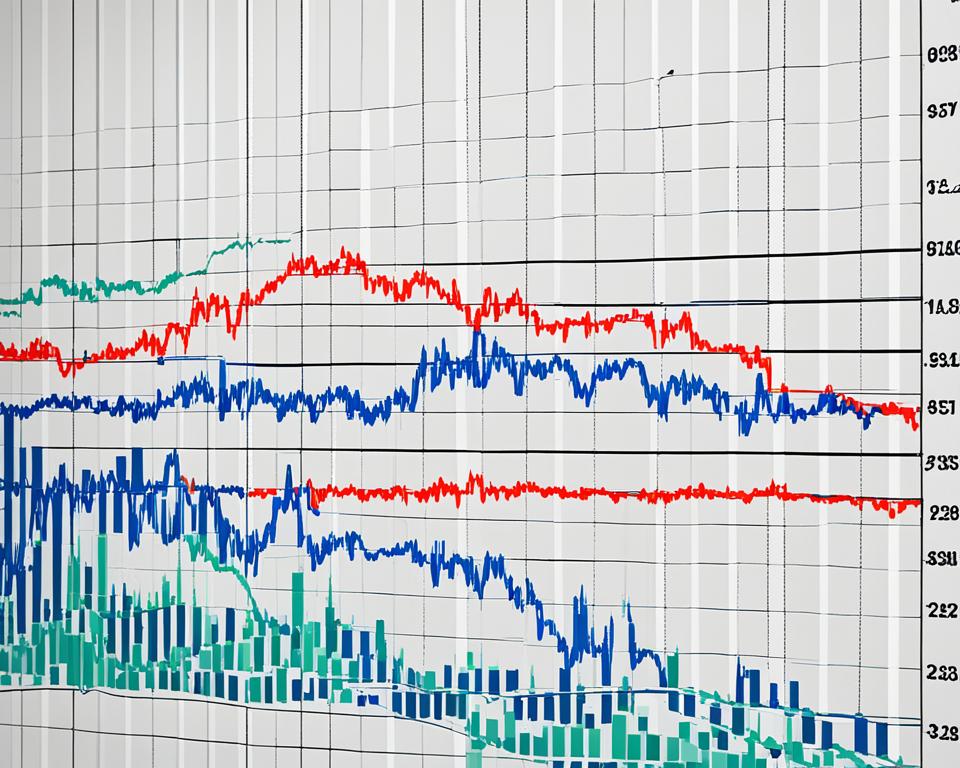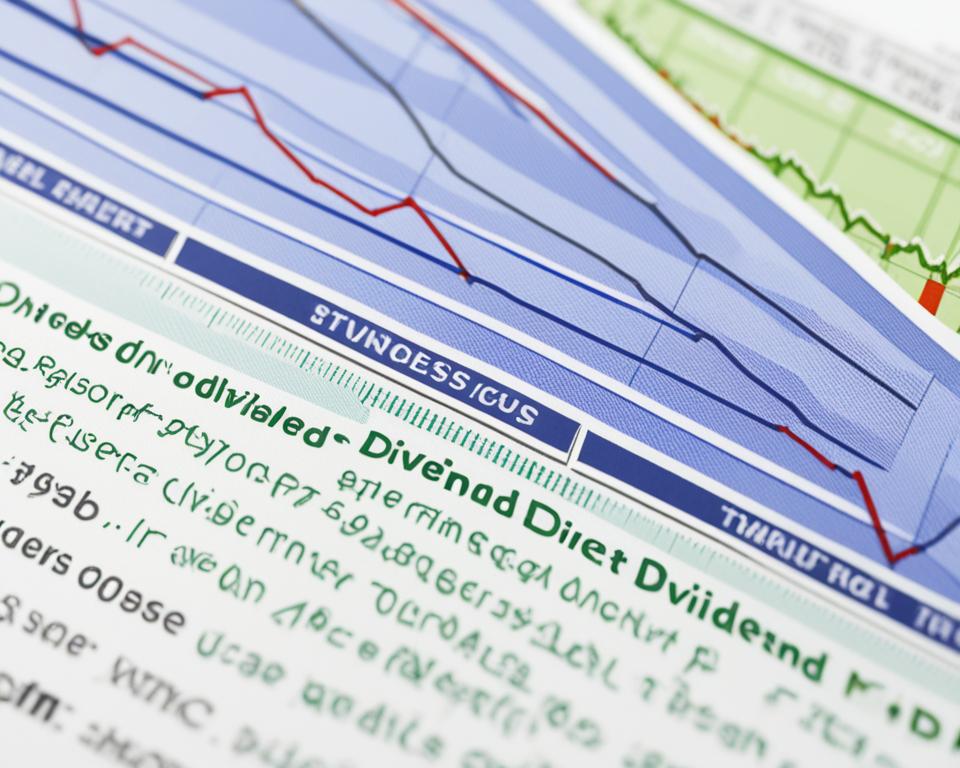When traversing the landscape of the stock market, savvy investors often seek out the stalwarts known for their unwavering commitment to shareholder value—dividend aristocrats and dividend kings. These bastions of financial stability not only provide regular payouts to their shareholders but also demonstrate an uncanny ability to continually increase said dividends, fostering a reputation for resilience and reliability. In the vast arena where broader market performance can oscillate with unpredictability, the dividend aristocrats performance emerges as a beacon of consistency. Similarly, dividend kings stocks represent a royal lineage within the investment kingdom, brandishing half a century’s worth of consistent dividend growth, honoring their regal title with steadfast princely returns.
The robustness of these dividend dynamos is most evident when viewed against the broader market’s performance. Oscillating market trends and volatile economic conditions have often left investors yearning for stability, and the aristocrats and kings have historically fulfilled this desire. They stand tall as embodiments of predictable financial fortitude, making them the much-coveted crown jewels of many investment portfolios.
Key Takeaways
- Dividend aristocrats, defined as S&P 500 companies with at least 25 years of consecutive dividend increases, offer a stable income stream.
- Dividend kings, boasting a lineage of over 50 years of annual dividend growth, provide a herald of dependability and strength.
- The dividend aristocrats’ performance closely parallels that of the broader market, yet they favor lower volatility.
- With histories rich in resilience, dividend kings stocks are esteemed for their capacity to surpass market averages.
- Investing in these esteemed stocks can serve as a strategic move towards portfolio diversification and risk management.
A Brief Overview of Dividend Aristocrats and Dividend Kings
Investors often speak of the resilience and consistency of certain stocks that provide more than just ownership in a company; they offer a legacy of growing shareholder value. These stocks are known as top dividend aristocrats and dividend kings, distinguishable by their long-standing record of incremental dividend payments. Linked to firms with stable earnings and robust financial health, they stand as a testament to disciplined and investor-focused corporate strategies.
Defining Dividend Aristocrats
Within the investment community, dividend aristocrats criteria serve as a benchmark of corporate excellence. To qualify as a dividend aristocrat, an S&P 500 company must have not only paid dividends but also increased the payout for a minimum of 25 consecutive years. This criterion underscores the ability of these companies to manage capital effectively, reassuring investors of their sustainable business models and commitment to sharing success.
Defining Dividend Kings
Ascending even higher in the hierarchy of dividend consistency is the esteemed group known as dividend kings. The dividend kings definition is quite straightforward, yet challenging for companies to achieve. These entities have raised their dividends for at least 50 years, surpassing the benchmark set by aristocrats and serving as paragons of unwavering financial dedication. Unlike aristocrats, kings are not restricted to the S&P 500, allowing for a broader universe of seasoned dividend-growers.
Key Characteristics of Top Dividend Aristocrats and Kings
The upper echelon of dividend-paying stocks, including the top dividend aristocrats and kings, shares several key characteristics. These companies typically present durable competitive moats, steady command over market segments, and unwavering revenue streams that can withstand economic cycles. Their ability to reward shareholders consistently through thick and thin positions them as pinnacles of investor trust and corporate reliability.
| Criteria | Dividend Aristocrats | Dividend Kings |
|---|---|---|
| Consecutive Years of Dividend Increases | 25+ | 50+ |
| Index Membership | S&P 500 | Not Required |
| Market Capitalization | Typically $3 billion+ | Varies |
| Economic Resilience | High | Very High |
| Examples | 3M, Johnson & Johnson | Tootsie Roll Co., Dover Corporation |
Interpreting the data from the table above reveals the stringent yet profoundly advantageous requisites these companies meet, thereby placing them in the pantheon of steadfast investment options.
Performance Analysis: Dividend Aristocrats vs S&P 500
An examination of the dividend aristocrats list alongside the S&P 500 reveals a fascinating parallel in terms of long-term returns. By and large, the individuals and funds that have focused on these venerable stocks have encountered a path sprinkled with stability and less turbulence, particularly in their income flow. As we launch into a comparison between these time-tested players and the broader market, the depth of their financial resilience begins to come into sharper focus.
Comparing Long-Term Returns
The tapestry of the stock market is rich with a variety of patterns, but the dividend aristocrats performance stands out for its consistent texture. Historical analysis spanning a decade showcases a synergy between the dividend aristocrats and the S&P 500, each delivering an average annual return hovering around 14%. This synergy is particularly compelling when considering the stability dividend aristocrats bring to the table—a result of their adherence to a policy of sharing profits in a predictable, growing fashion.
Understanding Volatility and Risk Profiles
Delving deeper into the proverbial fabric, the volatility and risk profiles of the dividend aristocrats diverge significantly from the mainstream S&P 500 index. Their tendency to maintain lower volatility can be attributed to their mature stature and fundamental sturdiness, aspects which might dampen sky-high growth but offer a shield during market storms. The story told by the dividend aristocrats is one of prudence—a saga where a steady hand on the wheel has navigated through the choppiness of economic seas, asserting a distinctive identity within the investment realm.
The Resilience of Dividend Aristocrats and Kings During Market Turmoil
Investors seeking stability during times of market turbulence have long valued the dividend aristocrats performance and the enduring quality of dividend kings stocks. These symbols of robust dividend reliability have consistently proven to be steadfast, especially during economic downturns. It is this resolute characteristic that has marked them as premier choices for those wanting to shield their investments from the extremes of market fluctuations.

Economic Downturns and Dividend Reliability
Despite the uncertainties introduced by economic downturns, dividend aristocrats and kings exhibit a compelling degree of reliability. These entities have defied market adversities to uphold dividend growth, reassuring investors of their dependable nature. The performance of dividend aristocrats, in particular, often reflects their capacity to weather financial instability and maintain dividend distributions, solidifying their reputation as consistent contributors to shareholder wealth, even in precarious times.
Dividend Aristocrats and Kings as Safe Haven Assets
Amidst the unpredictability of stock market movements, dividend aristocrats and kings are frequently categorized as safe-haven assets. Their track record during recessions, such as the pandemic in 2021, stands as a testament to this classification. At a time when various sectors were grappling with the repercussions of the global crisis, an impressive count of 65 dividend aristocrats succeeded in maintaining, if not enhancing, their dividends. This unwavering commitment secures them a coveted position in the portfolios of investors, particularly those with a strategic eye towards resilience in their investment journey.
- Dividend Aristocrats: 25+ years of increasing dividends.
- Dividend Kings: 50+ years of progressive dividend growth.
- Defiance of downturns: Consistent performance regardless of economic conditions.
- Offer of stability: Serving as dependable income sources.
The astute investor, perceptive of market rhythms and cautious of volatile swings, can find solace and strategic advantage in the heritage of dividend aristocrats and kings. These entities not only symbolize financial resilience but also act as anchor points that ensure portfolio buoyancy amidst the often stormy seas of the economic world.
Evaluating the Steady Growth of Dividend Aristocrats Dividend Kings
The inveterate pursuit of steady growth defines the financial backbone of both dividend aristocrats and dividend kings. These terms epitomize the sustained success of companies that have consistently rewarded shareholders with rising dividends. Let’s delve into the growth patterns that have propelled the best dividend aristocrats and observed the definitive growth that makes dividend kings an elite class within the investment sphere.
Year after year, despite economic cycles and shifting market trends, these organizations adhere to a model that accentuates incremental rewards for those invested in their future. It is their ability to maintain and increase dividends annually that has solidified their status among discerning investors. One such emblem of resilience and commendable fiscal policy is Archer Daniels Midland (ADM), which marched into the ranks of dividend kings in 2024, commemorating five decades of consecutive dividend growth.
| Company | Years of Consecutive Dividend Growth | Current Dividend Yield | Market Capitalization |
|---|---|---|---|
| Archer Daniels Midland (ADM) | 50 | 2.5% | $33 Billion |
| Procter & Gamble (PG) | 67 | 2.3% | $344 Billion |
| The Tootsie Roll Co. (TR) | 54+ | 1.1% | $2 Billion |
| Johnson & Johnson (JNJ) | 61 | 2.6% | $433 Billion |
Dividend kings growth isn’t just about the numbers on a chart; it’s the reflection of deep-rooted corporate governance dedicated to shareholder value. This orientation towards a future of prosperity is inherently embedded within the very DNA of such companies, building a legacy that resonates with steadfastness and assurance.
- Steady Growth: The hallmark of dividend aristocrats and kings, defining their unique appeal in the investment world.
- Best Dividend Aristocrats: Noted for their robust financials and the consistency with which they have amplified shareholder dividends.
- Dividend Kings Growth: A testament to the transcendent nature of such stocks, characterized by their unyielding dividend enhancement over 50 years or more.
The fabric of financial fortitude woven by these companies predicates not on momentary gains but on the enduring creation of wealth. Investors who value consistency, reliability, and the foresight to invest in corporations with a proven track record of dividend growth may find solace and strategic benefit in this tier of stocks.
The Role of Dividend Aristocrats and Kings in a Balanced Portfolio
Investors crafting a balanced portfolio often turn to the likes of the dividend aristocrats index and the hallowed halls of dividend kings for dependable income streams. Much like selecting the perfect ingredients for a gourmet meal, including these investment vehicles in one’s portfolio, particularly when considering retirement portfolios, adds a flavor of stability and certain robustness. As these stocks boast a remarkable history of consistent dividend increases, they provide the income reliability so crucial for retirees planning their financial futures. Nevertheless, the choice between income investment strategies and growth investment strategies should be tailor-made to meet the individual investor’s lifecycle and financial goals.
Inclusion in Retirement Portfolios
With longevity on the rise and the uncertainty that accompanies living on a fixed income, the priority for retirees stretches beyond mere survival to ensuring a life of financial comfort. The bedrock of earning power in retirement portfolios is frequently furnished by dividend aristocrats and kings due to their proven track record of growing dividends. They serve as the cornerstone, allowing for the semblance of a paycheck in a post-retirement reality, grounding the portfolio in a predictable return.
Assessing Income versus Growth Investment Strategies
While the relative safety of dividend aristocrats and kings is attractive, it’s paramount for investors to weigh the merits of income investment strategies against growth investment strategies. Whereas the former leans into the steady, albeit potentially lower returns of stalwarts in the dividend aristocrats index, the latter angles for the potentially higher, yet riskier capital gains sought after by growth-focused investors. Juxtaposition of these strategies becomes even more pressing when the vista of one’s investment horizon is short; the fast-approaching nature of retirement may mandate a preference for the income-generating reliability of dividend issuers.
Given this strategic dichotomy, the task at hand for savvy investors involves a careful evaluation of one’s risk tolerance, the desired level of income generation, and growth potential. All these factors, shaken and stirred effectively, can concoct a balanced portfolio suited to each person’s bespoke financial palate. The calibration of such a portfolio should incorporate the proportionate inclusion of dividend-yielding securities, whether for the tranquil waters of retirement or the aggressive tides of wealth accumulation.
As a concluding nod to the reflective process integral to structuring one’s investments, here’s a presentation of how dividend aristocrats and growth stocks might be evaluated within a portfolio matrix. This comparison, devoid of finality but full of analytical rigor, provokes contemplation for individual financial paths.
| Investment Strategy | Focus | Suitability | Expected Returns | Volatility |
|---|---|---|---|---|
| Income Investment (Dividend Aristocrats/Kings) | Stable dividends, lower risk | Retirees, Conservative Investors | Lower compared to growth stocks | Lower |
| Growth Investment | Capital appreciation | Younger Investors, Risk-takers | Higher, if the growth strategy succeeds | Higher |
Dividend Aristocrats Criteria and their Impact on Performance
Investors who favor reliable income streams and sustained growth look to dividend aristocrats as a cornerstone of their portfolios. The prestige associated with being labeled a dividend aristocrat comes from adhering to strict criteria that signal consistency, reliability, and financial prowess. Central to these criteria are the requirements for S&P 500 inclusion and the heralded milestone of a 25-year streak of dividend increases.
Understanding the S&P 500 Inclusion Requirement
Becoming an S&P 500 dividend aristocrat isn’t just about having a strong track record of payouts; it’s also about the company’s standing within the broader market. S&P 500 inclusion is pivotal, ensuring that the company is not just a random player but a fundamental piece of the market’s tapestry. This inclusion implies a substantial level of market capitalization, liquidity, and, critically, visibility in the investment community.
Such stature is indispensable in accruing the trust and investment of shareholders, postulating a company’s size and stability as a significant factor in its ability to maintain and grow dividends. This transparency and accountability assert why S&P 500 inclusion is an indispensable part of the dividend aristocrats criteria.
Assessing the 25-Year Dividend Increase Criterion
Similarly, the criterion of consistent dividend growth over a minimum of 25 years stands as a testament to a company’s unshakable commitment to its shareholders. This remarkable feat of maintaining a quarter-century streak of dividend increases is synonymous with exceptional fiscal management and strategic agility.
Year over year, companies meeting this criterion have showcased financial stability and shareholder-centric decision making. Notably, this dedication is reflected in the comparable returns of the dividend aristocrats to the overall S&P 500, attracting those investors who covet steady and foreseeable returns over more speculative growth avenues.

It’s evident how these dividend aristocrats criteria, specifically the 25-year dividend increase and S&P inclusion, become more than just benchmarks—they encapsulate a company’s financial narrative. These criteria have positively impacted the performance of companies, fostering investor confidence and ensuring a sacred place within the investment community for dividend aristocrats.
In the realm of investment where certainty is a cherished commodity, these criteria have consistently underlined the allure of dividend aristocrats. They reassure investors with a predictable yield, while also painting these select companies as portraits of financial resilience—beneficial characteristics during both recession-proof and buoyant market conditions.
Exploring Dividend Kings Stocks and their Path to Prestige
Embarking on the financial journey of long-term investment can lead one to discover the esteemed realm of dividend kings stocks. These are not your average equity offerings; they are the gems that have polished their reputations over decades. With exclusive dividend-paying stocks, the annals of economic history are littered with tales of ordinary investments, but dividend kings have carved out a lineage of regal distinction defined by their historical performance and consistent investor rewards.
Highlighting Historical Performance of Dividend Kings
The ascension to royalty within the stock market is marked by enduring resilience. Dividend kings, recognizing the significance of loyalty to shareholders, have not simply maintained but methodically augmented their dividends through thick and thin. This extraordinary historical performance underscores a commitment to financial stability and investor confidence that separates these stocks from their contemporaries. Their ability to provide market-beating returns is not merely a stroke of luck but the fruit of prudent financial stewardship and strategic business conduct.
Specific Qualities that Set Dividend Kings Apart
What distinguishes dividend kings stocks from their noble peers is a combination of definitive traits. These companies possess durable competitive moats that safeguard them against the harsh volleys of market competition. Their financial ramparts are built with the solid mortar of steady profit generation, enabling not only survival but the capacity to thrive across various economic conditions. Dividend kings represent a lineage of corporate aristocracy, found in the exclusive layer of dividend-paying stocks that prioritize the sustained increase of shareholder returns over short-term financial maneuvers.
As we delve deeper into what makes these stocks truly sovereign, we uncover the economic prowess that enables a dividend king to stand apart:
- Consistency: A trait mirrored in their half-century or more of consecutive dividend increases.
- Adaptability: Their ability to navigate through different economic cycles, adapting and growing regardless of the market’s vicissitudes.
- Shareholder-centric approach: Not only surviving but committing to shareholder value, continuously prioritizing dividend growth.
The crowning characteristic of the dividend kings is their historical performance, which reveals a saga of sustained excellence. It’s a testimony to both their past endeavors and their promise for the future—a future where the dividends continue to flow with kingly grace, rewarding those who pledge their fealty to these elite, durable, and exclusive dividend-paying stocks.
Best Dividend Aristocrats in the Current Economic Climate
As seasoned investors navigate the landscape of the current economic climate, they naturally gravitate towards the best dividend aristocrats. These companies not only stand as pillars of reliability amidst fluctuating market trends, but they also exemplify the principle of dividend growth—an aspect critically important to those whose portfolios are built upon steady income. In this era of economic uncertainty, the selection of dividend-yielding stocks becomes a crucial point of focus for a resilient investing strategy.
When scouting for investment havens, it’s essential to examine the firms leading the charge in their respective industries. Both Procter & Gamble and Colgate-Palmolive have demonstrated a remarkable capacity to maneuver through challenging economic headwinds. Their successful management of raw material price fluctuations and the ability to continuously grow sales volumes stand as commendable feats, deserving recognition among the pantheon of best dividend aristocrats.
Analyzing Market Trends and Dividend Growth
Key to understanding the robustness of dividend aristocrats lies in deconstructing current market trends and analyzing the trajectories of dividend growth. Even when economic indicators sway and consumer behaviors shift, the top dividend aristocrats maintain a progressive dividend policy. Through the lens of market analysis, these stocks reflect a company’s nimbleness in adapting business strategies to changing market dynamics whilst ensuring shareholder value is not compromised.
The present economic scene is dotted with changing consumer preferences and technological advancements that compel companies to adapt. Yet, consistent dividend growth emerges as a beacon of commitment to long-term financial health, a trait investor’s prize in an ideal candidate for their portfolio.
Spotlight on Industry Leaders and Best Performers
Looking to the industry leaders, certain names resonate with authority within the investment community. Not only do these firms capture the essence of the best dividend aristocrats, but their performances also set a benchmark for what it means to be stalwarts of dividend growth. It is crucial to spotlight these best performers as their actions today will undeniably shape the investment landscape of tomorrow.
As the quest for the best dividend aristocrats continues, investors will marinate on the information provided, hoping to distill the essence of market winners—those with the resilience to thrive amid turbulence and the foresight to generate enduring wealth.
Reviewing the Dividend Aristocrats Index and its Impact
The Dividend Aristocrats Index has long been a flagship measure for investors looking to secure a portfolio fortified by reliability and growth. Recognized for its stringent requirements, the index serves as an essential gauge for analyzing established companies that are proven in their ability to provide continuous dividend growth. In this section, we explore the specifics of the index composition and how it informs investor decisions, as well as track the performance trends that highlight the index’s significance within the investment community.
Index Composition and Influence on Investor Decisions
Influencing the foundations of investor decisions, the index composition comprises companies that are not just dividend payers, but dividend growers. Each member of the Dividend Aristocrats Index has consistently increased their dividends for at least 25 years, cementing their status as financial stalwarts. These corporations come from various industries, providing a diversified approach to income investing. Their inclusion in the index carries the implied reputation of solid fundamentals and a shareholder-friendly outlook, leading many to consider them as primary contenders for a defensive, income-focused portfolio allocation.
Tracking Performance Trends in the Dividend Aristocrats Index
Over time, the performance trends of the Dividend Aristocrats Index have offered a compelling narrative of stability and resilience. Even amidst market turbulence, companies listed within this venerable index have managed to demonstrate both capital appreciation and reliable dividend growth, often outstripping the yield offered by standard saving instruments. By monitoring these trends, investors are able to get a pulse on the health of dividends across key sectors, guiding decisions that balance both the pursuit of income and the potential for capital gains.

As a key indicator within the market, the Dividend Aristocrats Index remains pivotal for those who prioritize predictable and climbing returns. Its role extends beyond that of a mere benchmark, influencing a broad spectrum of investment portfolios from the risk-averse to those who favor a mix of growth and income.
Advantages and Disadvantages of Investing in Dividend Aristocrats
Dividend Aristocrats have long fascinated investors seeking a blend of stable returns and corporate solidity. These market mavens are often lauded for their advantages, encompassing both appealing yields and underlying organizational robustness. Yet within their revered status, certain caveats exist, including the spectre of overvaluation and a possible eclipse of growth prospects.
Pros of Steady Income and Strong Fundamentals
The advantages of dividend aristocrats lie in their propensity to furnish investors with a steady income. This derives from a history punctuated with increments in dividends, reflecting not only a company’s bullish prospects but also a dedication to rewarding shareholders. Complementing this aspect are the strong fundamentals typically manifest in companies holding the aristocratic title—formidable financial repositories that can ride out economic storms and maintain their regal dividend-giving stature.
Cons of Potential Overvaluation and Growth Limitations
Conversely, the disadvantages of dividend aristocrats muse on the flip side of the coin. Investors may encounter overvaluation risks, where a company’s stock price sails beyond fundamental valuations due to their coveted, dividend-consistent reputation. Moreover, growth limitations beckon—a narrative where the distribution of profits to shareholders potentially constricts capital reserved for reinvestment, stifling new business forays and capping the prospective capital gain heights one might otherwise expect.
Comparing Dividend Kings to Less Established Dividend Payers
The prowess of Dividend Kings in the realm of investments is not a matter of mere coincidence; it is backed by a rich legacy of fiscal dependability and shareholder commitment. Such prestigious standing draws a compelling contrast against the background of newer, less established dividend payers striving to mark their presence in the competitive dividend landscape.
Advantages of a Long Track Record
Dividend Kings, with their long track record of progressive shareholder rewards, offer more than just a pat on the back for investors. They convey a story of resilience, a dividend kings advantage that stands tall amidst the financial narratives of companies across the board. Their yearly increasing dividends reflect not just a pattern, but a principle they’ve upheld, weathering economic changes and policy shifts with strategic finesse. This commendable history props up investor confidence and fortifies the trust in their financial health.
Why New Dividend Payers Might Struggle to Compete
Beneath the canopy of time-tested Dividend Kings, new dividend payers emerge with the challenge of sculpting a niche in a domain where history speaks volumes. Without the longevity akin to the dividend monarchs, these nascent entities face the stark challenge of proving their worth. Without a substantial timeframe to demonstrate endurance, particularly through economic downturns, these companies may fall short in convincing potential investors of their reliability. The competition seems stark, as the caliber to persistently increase dividends over decades becomes a significant yardstick for success.
“While history does not predict the future, it certainly lays a foundational narrative which new dividend players find formidable to parallel.”
As the financial landscape expands, embracing both the old and the new, investor predilection leans towards entities that do not merely survive but thrive through time’s test. The dividend kings’ long-established ethos of value delivery casts a lengthening shadow, providing an exemplar in dividend distribution that new entrants aspire to and investors seek with vigor.
In conclusion, Dividend Kings sit enthroned upon legacies that span generations—an advantage that new market entrants cannot emulate overnight. It sets a premise for investors, especially those who regard dividends not just as a perk but a pivotal aspect of their investment strategy, to weigh tradition against novelty, historical assurance against prospective potential.
The Impact of Market Capitalization on Dividend Aristocrats and Kings
The significance of market capitalization cannot be overstated when it comes to dividend aristocrats and kings. Among the attributes that distinguish these stellar investment opportunities, market capitalization—a reflection of the total value of a company’s outstanding shares—stands out as a key factor. It is the impressive heft of market cap that often signals the enduring nature of large-cap dividend payers, while mid-cap and small-cap companies bring to the table their unique merits and potential for investor portfolios.
Large-cap Dividend Payers and Market Stability
When investors consider adding dividend aristocrats to their portfolios, they often gravitate towards large-cap dividend payers. These corporations, with their market capitalization exceeding $10 billion, are synonymous with market stability and a time-honored tradition of steady growth. Picking up the mantle of market leadership, companies like Johnson & Johnson and Procter & Gamble represent bastions of dependability. These large-cap entities, with their reliable financial performance and market footprint, form the backbone of any list highlighting dividend aristocrats and kings.
Mid-cap and Small-cap Dividend Payers in the Broader Market
Embracing a slightly different mantle in the investment universe are mid-cap firms and small-cap companies. Positioned between $2 billion and $10 billion in market capitalization, mid-cap firms tend to be well-established in rapidly growing industries. On the other end of the spectrum, small-cap companies, with their market caps beneath $2 billion, are often characterized by their growth potential and agility. While these firms may not offer the same extent of stability as the large-cap dividend payers, they hold their own by adding diversity and dynamism to an investor’s portfolio, particularly appealing to those who are willing to trade a measure of stability for the possibility of sharper growth trajectories within the broader market.
Sector Breakdown: Which Sectors Boast the Most Dividend Aristocrats and Kings?
Analyzing the sector breakdown of dividend aristocrats and kings uncovers a clear dominance by certain sectors renowned for their stable and consistent dividend increases. As the economy evolves, these sectors have proven to be fortresses of reliability for income-seeking investors.
Consumer Goods and Industrials: A Closer Look at the Numbers
In the realm of dividend-paying royalty, the consumer goods and industrials sectors have historically shone. In 2024, these industries have continued their legacy, jointly accounting for a substantial portion of the Dividend Kings roster. Companies within these sectors, due to their broad market presence and product necessity, have been adept at adjusting to economic ebbs and flows, manifesting in their ability to consistently reward investors with dividend increases.
| Sector | Number of Dividend Aristocrats | Number of Dividend Kings |
|---|---|---|
| Consumer Goods | 16 | 9 |
| Industrials | 12 | 18 |
Healthcare, Utilities, and Financials: Analyzing Their Presence
Not to be overshadowed, the healthcare sector, utilities, and financials have also marked their presence amongst the elite group of companies capable of sustaining dividends through thick and thin. Heavyweights like Johnson & Johnson reflect the healthcare sector’s commitment to investor value, while utilities and financial corporations provide a backbone of essential services, translating to a dependable stream of dividends.
| Sector | Number of Dividend Aristocrats | Number of Dividend Kings |
|---|---|---|
| Healthcare | 9 | 4 |
| Utilities | 4 | 9 |
| Financials | 7 | 5 |
The stratification of industry within the honor roll of dividend aristocrats and kings elucidates the diversified nature of companies poised for long-term, investor-centric success. Understanding the sector breakdown allows for a more nuanced approach to building an income-generating portfolio.
Conclusion
As we reflect on the investment landscape, it becomes evident that dividend aristocrats and dividend kings hold prestigious positions for those who prioritize long-term investments. The compelling performance of these stocks is not merely by chance; rather, it’s a testament to their enduring ability to deliver shareholder value consistently. For investors seeking savvy investments that offer more than just momentary gains, these categories represent financial prudence married with strategic growth.
Summing Up the Performance of Dividend Aristocrats and Kings
Considering their decades-long track records of dependable dividend growth, both dividend aristocrats and dividend kings stand out as preferred choices for income-seeking investors. These stocks not only provide a life raft of stability in uncertain market waters, but they also navigate the test of time with aplomb, illustrating why they are championed as wise and resilient components of a diversified portfolio. Their performance echoes the adage that true value and excellence are measured over years, not quarters, making them the embodiment of fiscal fortitude.
Final Thoughts for Investors Considering Dividend-Paying Stocks
While the allure of dividend aristocrats and kings is undeniable, astute investors are reminded to dissect these potentials beyond their illustrious titles. A thorough due diligence process, analyzing financial health and future outlooks, is paramount when integrating these stocks into a larger investment strategy. In an era characterized by quick shifts and sharp turns in the market, dividend aristocrats and kings remain steadfast beacons of security. They are not mere stocks; they are stalwarts of stability for those with a keen eye for savvy investments that navigate through the ebbs and flows of economic cycles.
FAQ
How do dividend aristocrats and dividend kings perform compared to the broader market?
Dividend aristocrats and kings have historically provided competitive long-term returns, matching or occasionally surpassing the broader market performance, with lower volatility and reduced risk profiles. They are known for their consistent and resilient dividend payments, offering a stable income stream to investors, especially during economic downturns or market turmoil.
What are the defining criteria for dividend aristocrats and dividend kings?
Dividend aristocrats are S&P 500 companies that have consistently increased dividends for at least 25 consecutive years. Dividend kings have raised their dividends annually for more than 50 years and are not restricted to the S&P 500 index. Both sets of companies are known for their financial stability and commitment to returning value to shareholders.
What are the key characteristics of top dividend aristocrats and kings?
The top dividend aristocrats and kings typically possess durable competitive moats, consistent earnings, and the ability to grow while continually providing returns to shareholders through increasing dividends. These companies are often considered less risky and are sought after by investors who prioritize stable and predictable income.
How do dividend aristocrats and kings fare during economic downturns?
Dividend aristocrats and kings are often considered to be resilient during economic downturns due to their history of steady profit generation and consistent dividend growth. They are frequently viewed as safe-haven assets, sought out by investors looking for stability and reliability when other growth stocks might be faltering.
Why is steady growth significant for dividend aristocrats and kings?
Steady growth in dividend payments showcases the financial health of a company and its ability to steadily reward shareholders. This consistent growth is particularly significant for income-focused investors and those seeking to mitigate risks associated with market volatility.
What role do dividend aristocrats and kings play in a balanced portfolio?
Dividend aristocrats and kings can provide a stable income stream, making them a vital component, particularly in retirement portfolios. They offer investors a balance between income generation and potential for modest capital appreciation, which is crucial for a diversified investment strategy.
How does the inclusion in the S&P 500 affect dividend aristocrats?
Inclusion in the S&P 500 index requires companies to meet specific standards related to size, liquidity, and market representation. This status as a dividend aristocrat signifies a track record of financial stability and a commitment to shareholder value, factors that are appealing to many investors.
Why are dividend kings considered prestigious investments?
Dividend kings have withstood various economic cycles and maintained a policy of growing dividends for over 50 years, highlighting exceptional management and financial health. Their prestige is rooted in their long history of outperforming many other investments and providing a trustworthy income source.
Which are the best dividend aristocrats in the current economic climate?
The best dividend aristocrats are typically those that adapt well to changing market conditions, exhibit strong management, and can sustain their dividend growth trajectory. They navigate the economic climate successfully and maintain robust sales and profitability.
What is the Dividend Aristocrats Index and how does it impact investors?
The Dividend Aristocrats Index tracks companies that consistently increase their dividends and are seen as having strong fundamentals. Its composition affects investor decisions by exemplifying companies with a history of stability and a reliable source of income.
What are the advantages and disadvantages of investing in dividend aristocrats?
Advantages of investing in dividend aristocrats include a steady source of income and typically strong company fundamentals, indicating financial resilience. The disadvantages may include potential overvaluation risks and the possibility of limited company growth due to significant profit distribution to shareholders.
How do dividend kings have an advantage over new dividend payers?
Dividend kings have a long-established track record of consistently increasing dividend payments, which new dividend payers lack. This history provides evidence of financial stability and dependability, qualities particularly valued during uncertain economic times.
How does market capitalization affect dividend aristocrats and kings?
Market capitalization can signal the perceived stability and growth potential of a company. Large-cap dividend payers are often seen as more stable and likely to have a long-standing history of dividend increases, whereas mid- and small-cap companies may be seen as having higher growth potential but possibly lesser stability.
Which sectors boast the most dividend aristocrats and kings?
Historically, consumer goods and industrials sectors have a significant number of dividend aristocrats and kings, due to their ability to pass on inflation costs and consistent cash flow. Healthcare, utilities, and financials also have a strong showing, reflecting their capacity for stable earnings and resilient business models.












